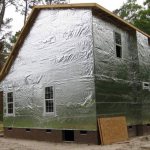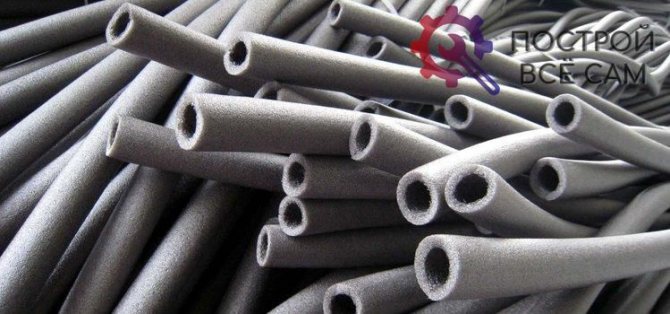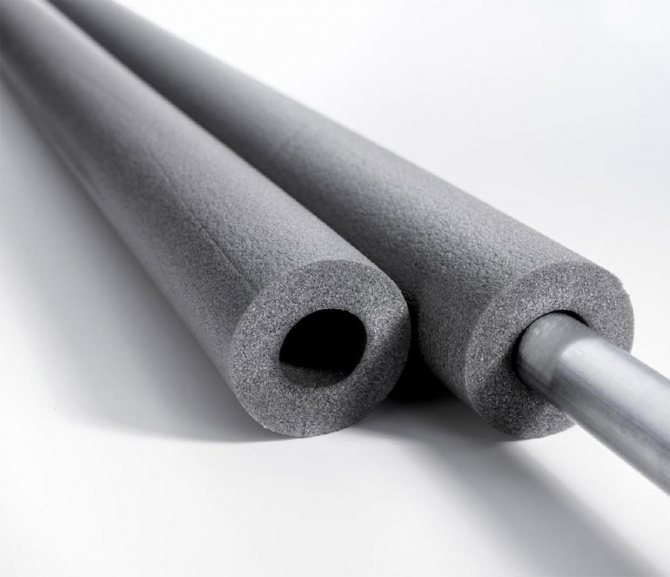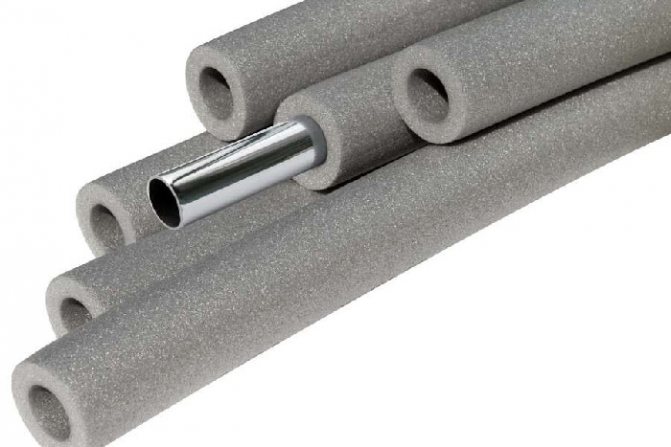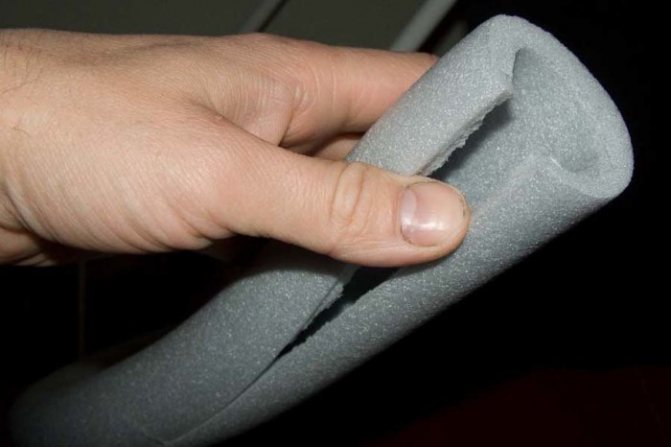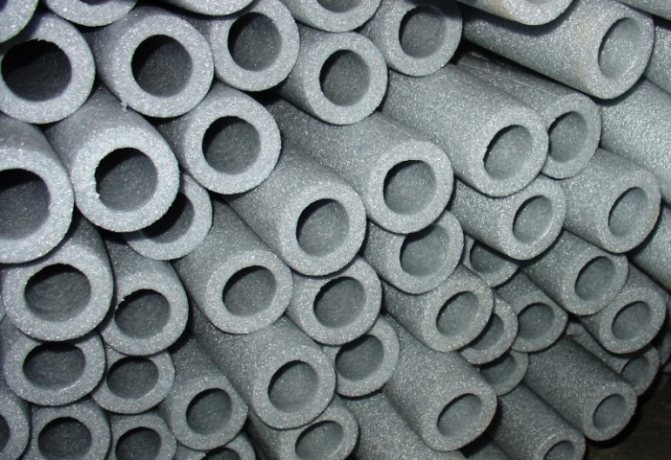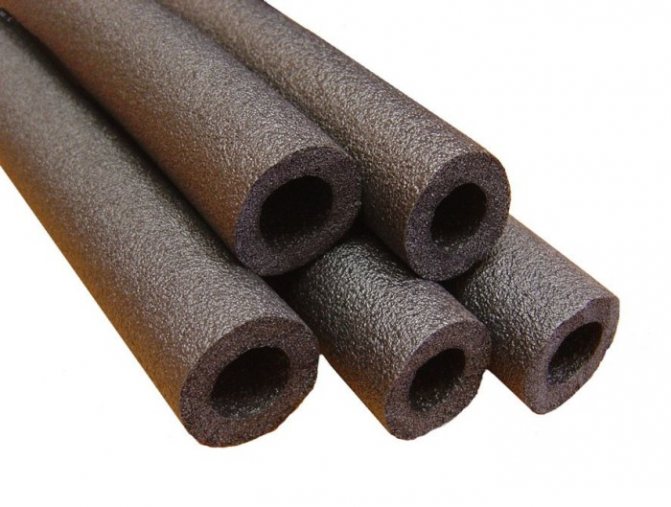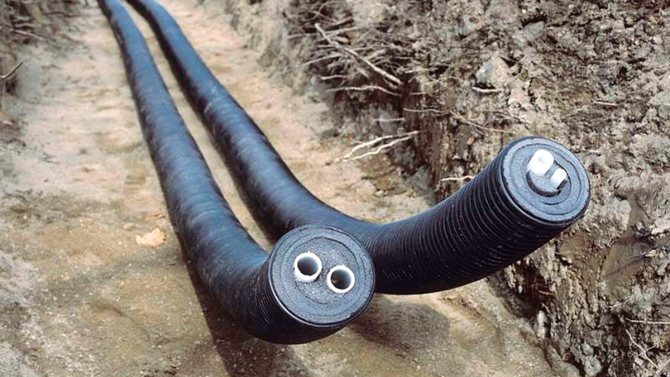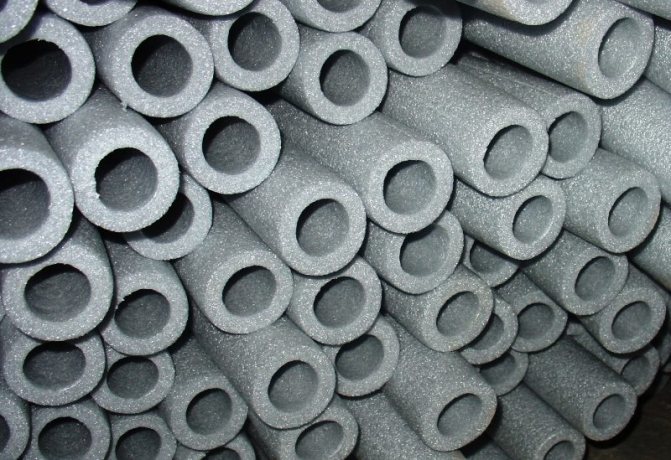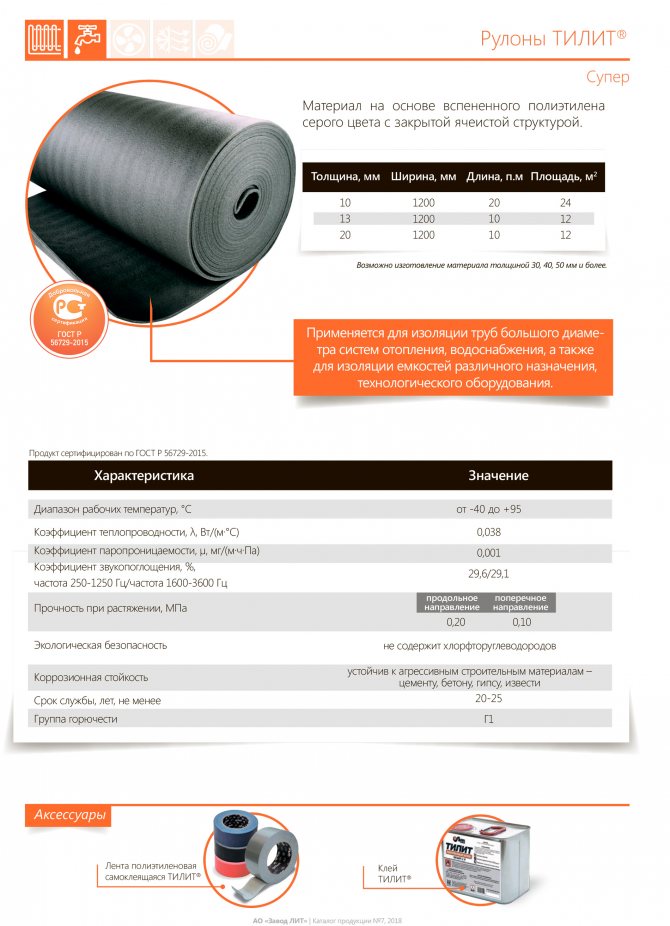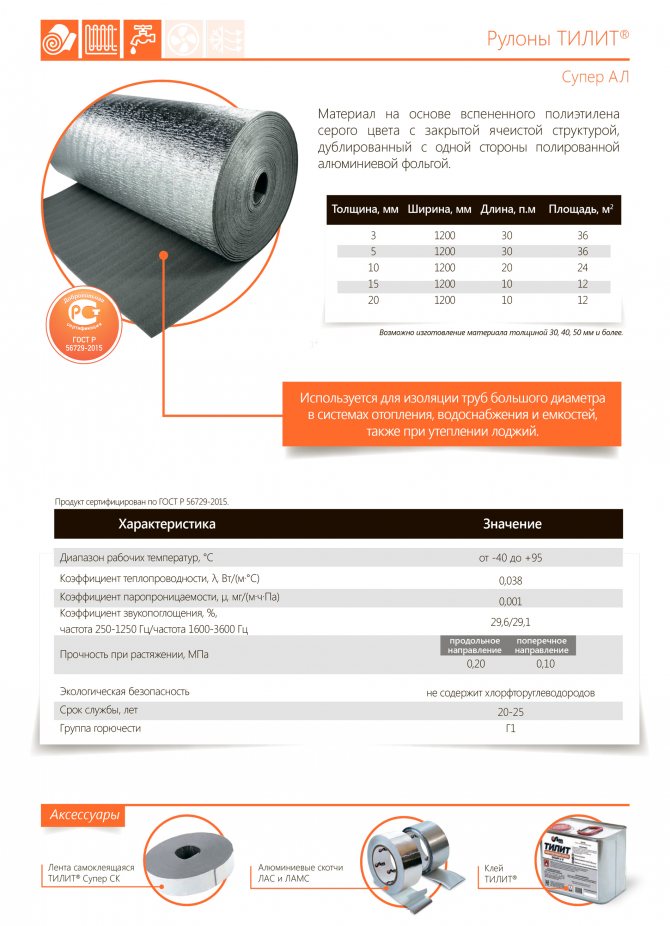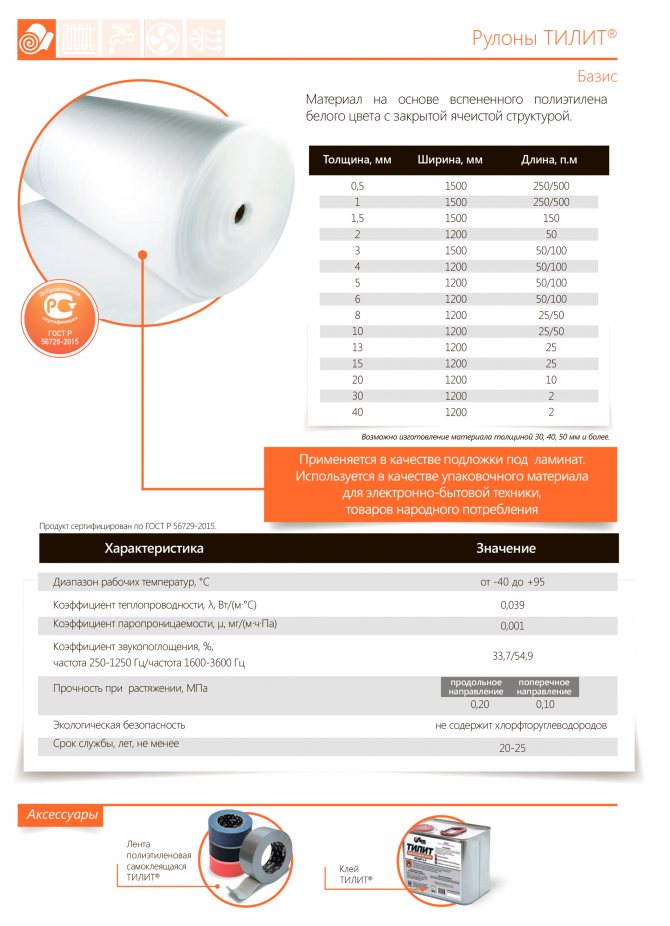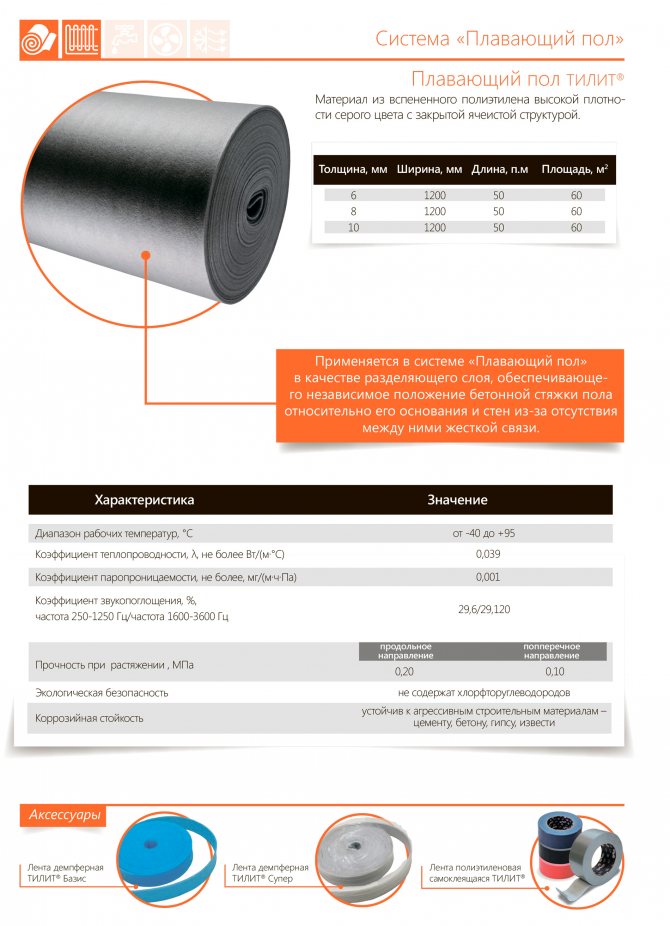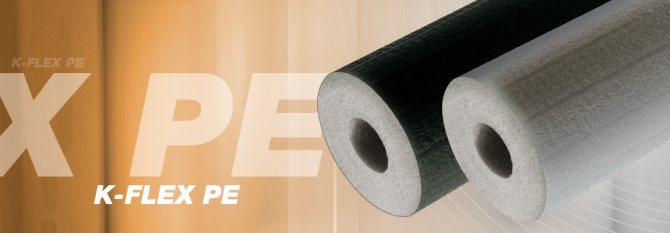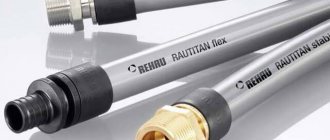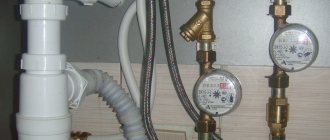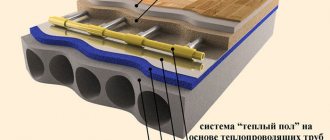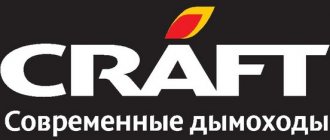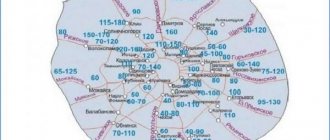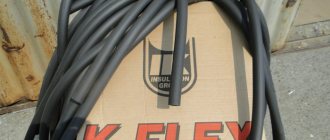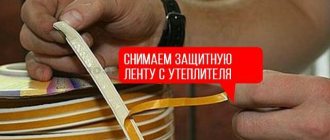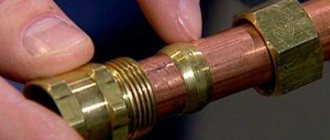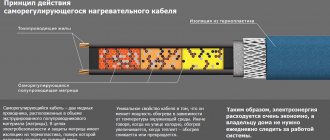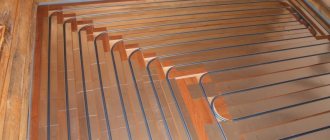Areas of use
Foamed polyethylene shells are used for pipe insulation:
- Heat supply.
- Hot and cold water supply.
- Sewerage systems.
- Air conditioning installations.
- Ventilation ducts.
- Refrigeration equipment.
Insulation sheet based on polyethylene foam is used to isolate:
- External and internal surfaces of the walls of buildings.
- Basements, foundation structures.
- Attic rooms.
- Roofs.
- Steam rooms, saunas, baths.
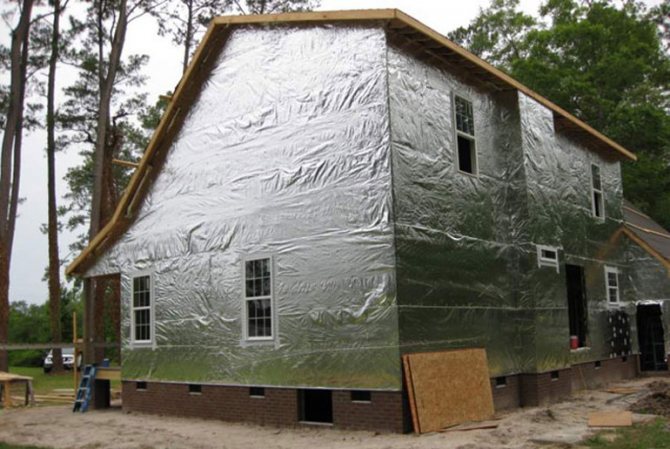
Foamed polyethylene bundles are used to seal:
- Interpanel seams.
- Cracks in window and door fillings.
Comprehensive protection is the main advantage
The main factors that pipelines require protection against are:
- Freezing. Pipeline bursts due to freezing of the substance transported through them is the main scourge of the winter period.
- Heat loss. Most modern materials from which pipes are made have high thermal conductivity, as a result of which heat losses can reach very significant indicators (more than 50%), which significantly reduces their energy efficiency and increases the cost of utility bills by an order of magnitude.
- Soundproofing. Often this is an additional beneficial "bonus" of thermal insulation materials, which makes it possible to reduce the amount of technologically conditioned noise (structural vibrations).
- Protection against corrosion, mold and mildew. A high degree of moisture absorption can reduce the service life of communications.
Insulation for pipes made of foamed polyethylene is able to provide effective protection against all these factors.
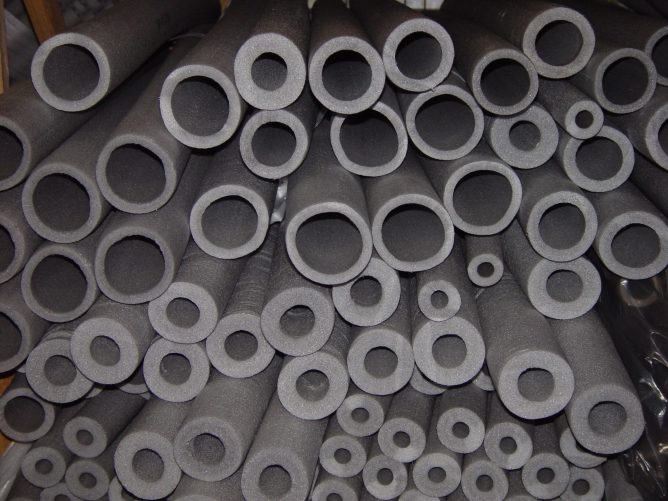

Manufacturing technology
Low density polyethylene (HDPE) granules are poured into the hopper, where they melt and are evenly mixed. Further, the resulting mass is subjected to foaming with gas or special reagents. At this stage, pigments and modifying additives are introduced into the melt. Then the heated mass is pressed through an extruder to give the insulation to the required shape.
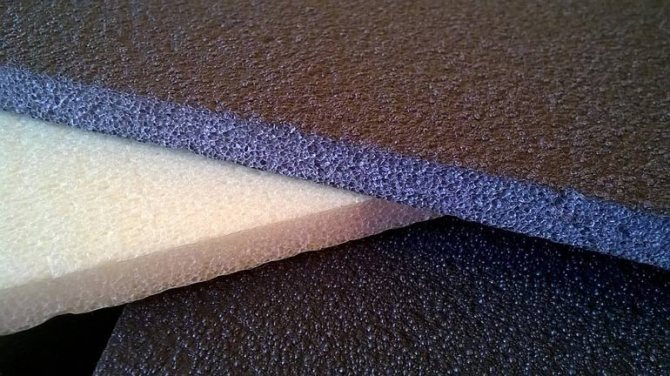

Advantages and disadvantages
Thermal insulation for polyethylene foam pipes is endowed with numerous advantages:
- High thermal insulation properties. Its application allows to reduce heat loss up to 75% and to provide liquids with the same temperature during transportation.
- Low hygroscopicity. Insulated pipes are less susceptible to corrosion, as they are protected from the penetration of moisture from the environment to their outer surfaces.
- Good vapor barrier effect. Condensation does not form on surfaces insulated with polyethylene foam; additional waterproofing is not required when insulating pipes.
- Ability to withstand temperature extremes in the range from -80 to +95 ºС. Thanks to this property, the insulation can be used in difficult conditions.
- Soundproofing qualities. Foamed polyethylene absorbs sounds from the circulating fluid in communications, partially dampens the level of structure-borne noise.
- Low weight. Insulation with lightweight polyethylene foam pipes will not lead to a significant increase in the load on utility networks.
- Easy to install - no special hardware required.
- Ability to quickly recover to its original shape after compression.
- Biological stability. Foamed polyethylene is resistant to the formation of fungal deposits and mold.
- Inert towards chemical elements.Polyethylene insulation does not lose its qualities from contact with various mortars, alkaline and acidic media, so they can be used to insulate pipes running through concrete structures or buried in the ground.
- Ecological cleanliness. Foamed polyethylene does not emit toxic substances, such insulation can be used for thermal insulation of pipes in educational institutions, medical centers, technological pipelines of food production, etc.
- Affordable price. For a relatively small amount, pipelines can be insulated along their entire length.
- Long service life - at least 30 years.


However, this insulation also has three main disadvantages:
- Low fire resistance. Expanded polyethylene quickly begins to melt under the influence of an open flame and can spread the combustion to nearby structures.
- Hypersensitivity to ultraviolet radiation. Foamed polyethylene under the influence of direct sunlight becomes brittle, crumbles and cracks. To compensate for this disadvantage, the insulation is covered with foil from the outside.
- Low mechanical strength. The insulation is easily damaged by a sharp object, and the gap can spread further along the length of the insulation. Therefore, damage must be immediately sealed with reinforcing tape.
Foamed polyethylene
What it is


Polyethylene foam does not withstand mechanical stress
Foamed polyethylene (polyethylene foam, PPE) is an insulating material that belongs to foamed plastics. Unlike expanded polystyrene, which is considered by many to be the only foam, PPE remains elastic after polymerization.
As a result, the insulation resembles foam rubber in its consistency and cannot withstand mechanical loads. Because of this, it is used very limitedly for thermal insulation of walls or floors.


The photo shows the cellular structure of the material.
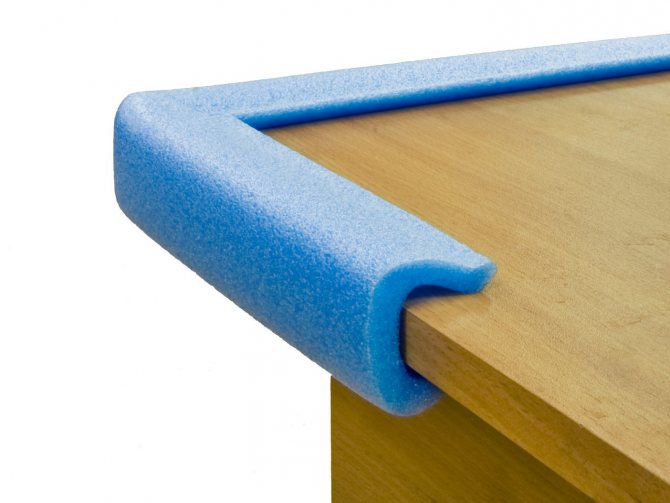

PPE is often used as packaging for furniture.
Polyethylene foam has a closed cell porous structure. This eliminates the saturation of the material with water and the penetration of water vapor through it. This feature has become one of the defining ones when choosing this polymer as a heat insulator for pipes.


Thermal insulation of pipelines is the main area of application of PPE.


The foil coating will protect the insulation from UV and IR radiation.
Foamed polyethylene pipes are easy to install both on the pipeline under construction and on the finished pipeline. This quality, along with low thermal conductivity, safety, chemical inertness and corrosion resistance, determined the popularity of the material, because today PPE is the most popular insulation for pipes.
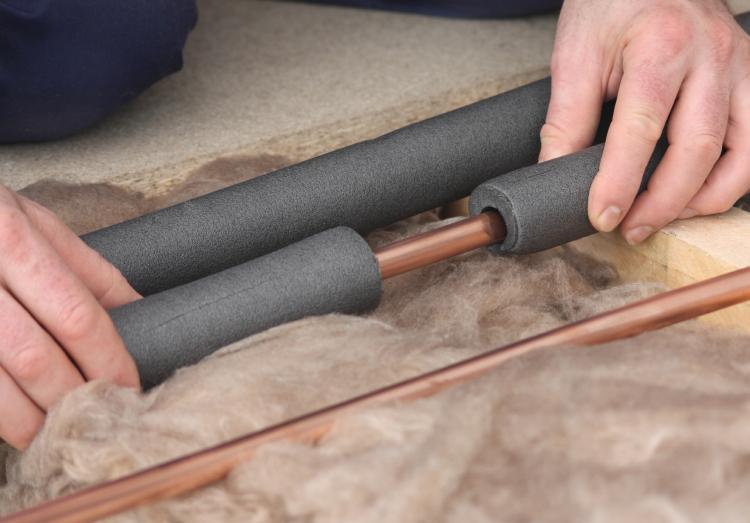

Installation of polyethylene foam can be done by hand.
Properties and features
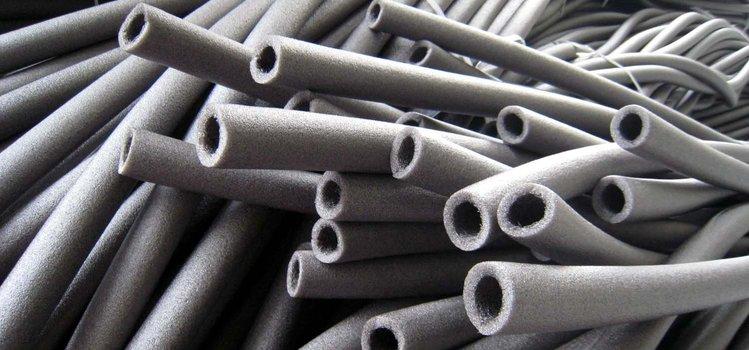

The tubing can be simply slid onto the tubing during system assembly.
Consider the technical characteristics of polyethylene foam in order to better understand its features.
To begin with, there are two types of polyethylene:
- Unstitched. This is an ordinary polymer, the molecules of which have no additional bonds in space. Differs in less strength, density, resistance to chemical environments and elasticity. In appearance it has larger cells, when compressed, it emits a crack and loses its original shape.
- Stitched... The material is melted and processed under special conditions so that unsaturated carbon radicals appear in the structure of the formula of the substance. Nearby radicals combine to form a spatial lattice of chemical bonds.
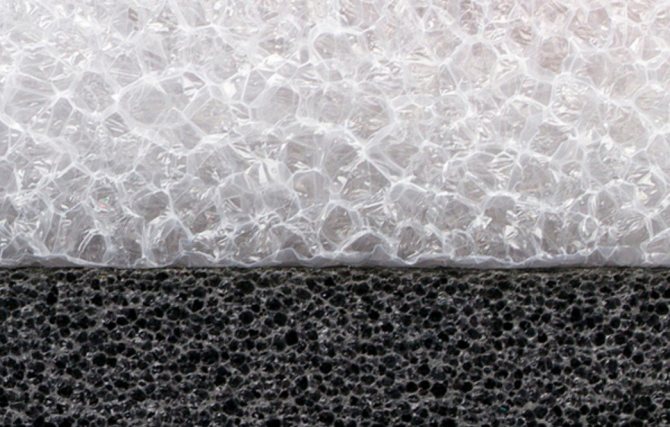

Non-stitched (top) and stitched (bottom) polyethylene.
When buying material, make sure that you are looking at the sewn PPE. Otherwise, thermal insulation made of foamed polyethylene will be of poor quality, quickly lose its shape and lose its properties.
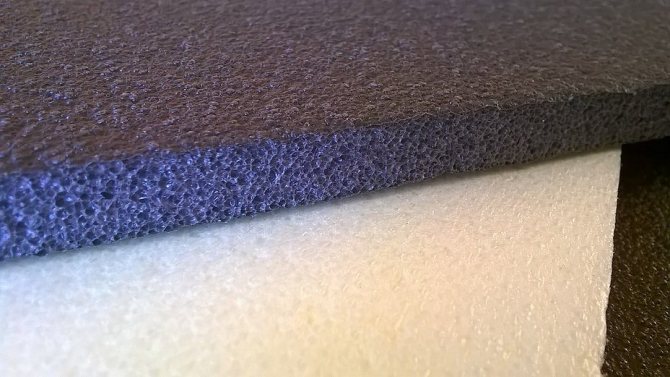

This is what chemically cross-linked polyethylene looks like in section.
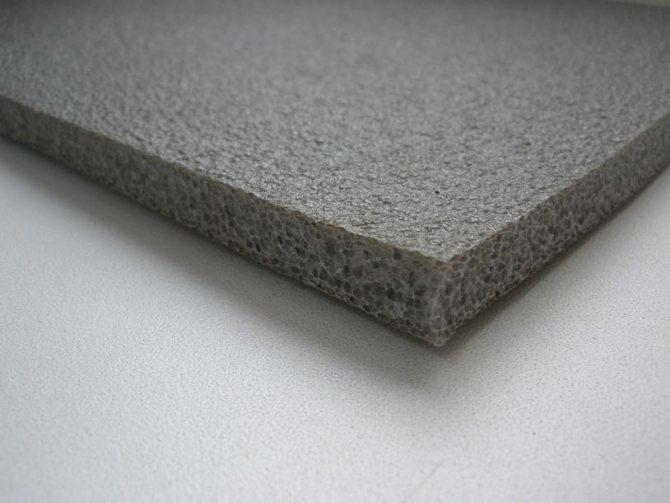

Another example of stitched foam.
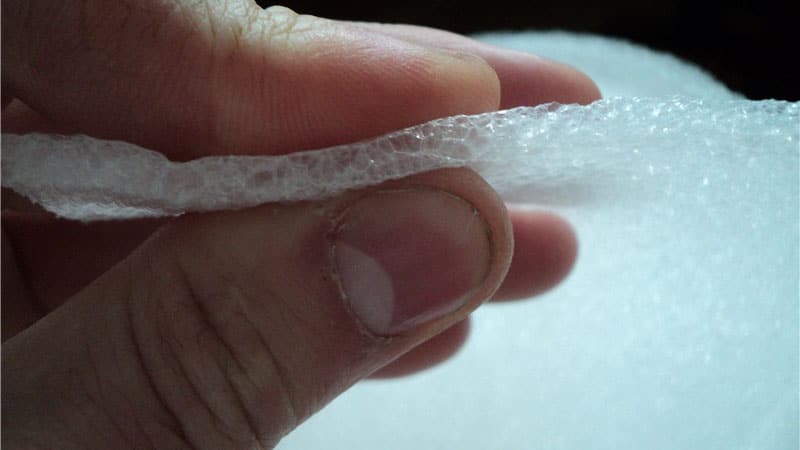

This photo shows the structure of uncrosslinked polyethylene.
Specifications:
| Property | Uncrosslinked PPE | Stitched PPE |
| Density, kg / m³ | 20-50 | 25-200 |
| Thermal conductivity coefficient, W / m * K | 0.038-0.039 | also |
| Water absorption,% by volume | 0.2 | 0.9-1.1 |
| Flammability group according to GOST 30244-94 | G2-G4 | G1-G4 |
| Vapor permeability coefficient, mg / m * h * Pa | 0.001 | also |
| Heat capacity, W / m * ̊ С | 1.8 | also |
| Group by the ability to smoke in accordance with GOST 12.1.044-89 | D3 | also |
| Durability | at least 25 years | 80-100 years old |
| Ability to keep in shape | low, medium | high |
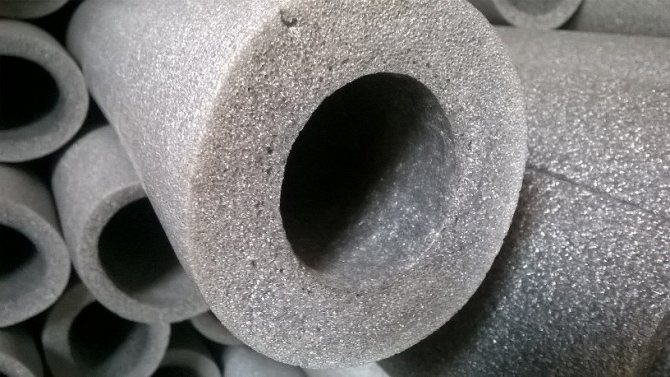

XLPE is more expensive than uncrosslinked polyethylene
From the characteristics it can be seen that the material belongs to high-performance heaters with a low coefficient of thermal conductivity. Cross-linked PPE is better suited for pipe insulation, although its price is noticeably higher. Nonetheless, crosslinked PES remains the most advantageous for this purpose.
Advantages and disadvantages
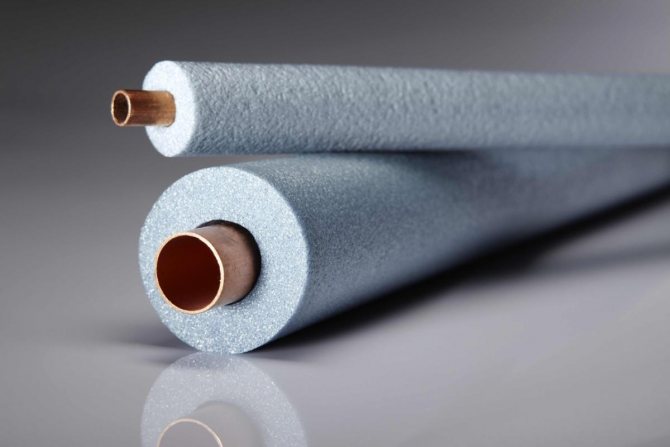

The inner diameter of the insulation must be the same as the outer diameter of the pipe.
Benefits:
- Low coefficient of thermal conductivity... As a result - high efficiency as a heater;
- High noise absorption coefficient... Consequently - high efficiency as sound insulation, you will not hear the sounds of water movement through the pipes;
- Moisture tightness and water vapor. This protects the pipes from condensation and corrosion. As a result, the pipes last longer;
- High resistance to corrosion - chemical, electrical, biological. As a result, the service life of the material can reach 100 years;


The temperature range that polyethylene can withstand is -60 to +90 ° C
- Low temperature resistance - the material is not afraid of low temperatures. Even at temperatures as low as -60 ° C, the polyethylene foam continues to maintain its elasticity and does not crack. The working temperature range is from -60 to +90 degrees;
- Lack of toxic secretions even while burning. Polyethylene does not release any toxins regardless of temperature;
- Ability to keep in shape... Even after strong compression, the material returns to its original shape and volume.


Combined use of PPE with a heating cable is allowed.
Disadvantages:
- Flammability... The material burns like any other foam. Thanks to fire retardants, the flammability can be reduced to G1 in accordance with GOST 30244-94, however, it is impossible to use PPE at temperatures above 102 degrees, since it will melt and lose its shape and properties;
- Fear of ultraviolet radiation... Foamed polyethylene decomposes when exposed to ultraviolet rays, so it is better to hide the insulation from solar radiation;
- Low strength... Polyethylene foam is not able to withstand compressive and bending loads, therefore, for normal operation, it must be spared them.
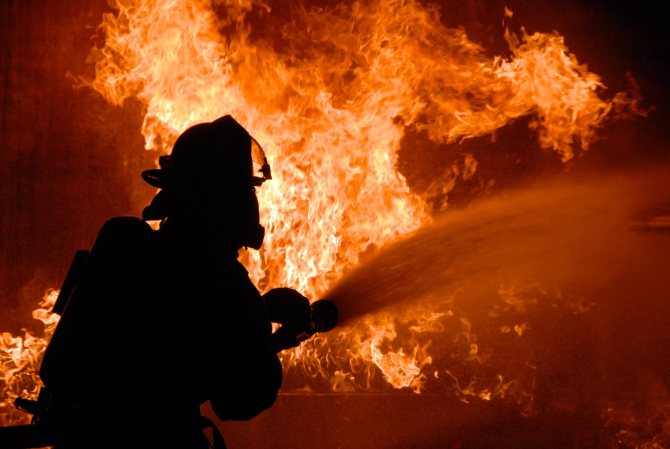

Like any plastic, PPE burns well.
Basic requirements for heat-insulating materials for pipes
Products for pipe thermal insulation must have:
- Low coefficient of thermal conductivity. The thickness of the foamed polyethylene insulation depends on this indicator. Communications in apartments run in cramped conditions, for their insulation, not only effective, but also small-volume materials are needed. The use of thin-walled shells as a heater for pipes will allow you to save more usable area in these rooms.
- Hydrophobic properties. Moisture reduces the insulating properties of any insulation, and with a large accumulation it can form the so-called cold bridges.
- Resistance to mechanical stress and environmental conditions, since pipes have to be insulated in open areas or under a layer of soil.
- Heat resistance. This requirement must be met by heaters used to insulate pipes for hot water supply and heating.
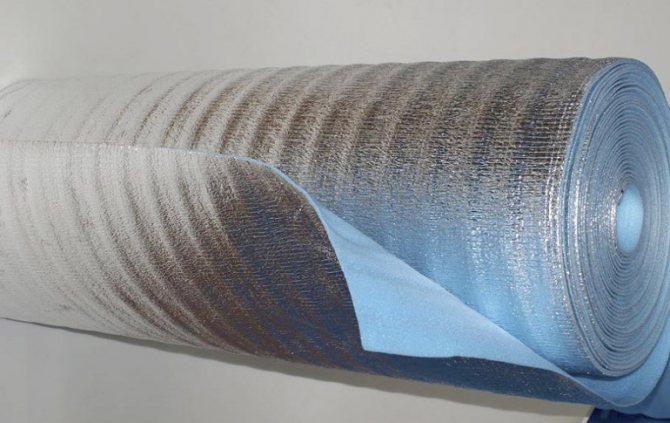

Main technical and operational characteristics
To understand the features of foamed polyethylene, you should study the technical characteristics of this insulation, it is produced in two types:
- Unstitched.
- Stitched.
The first type is a polymer, the molecules of which do not have additional bonds in space, due to which the material has less elasticity, strength and density, when compressed, a characteristic crackle is heard and the original shape is lost.
The second type is obtained by a chemical or radiation method, that is, under a specific external influence, not only linear, but also cross-links or in other words "crosslinking" are formed between the PES molecules, that is, the material turns out to be dense, strong and elastic, and after its compression the initial shape quickly is recovering. Therefore, in order for polyethylene foam pipe insulation to be of high quality and effective, it is better to give preference to products belonging to the second group.
Main technical characteristics of crosslinked insulating material:
- thermal conductivity - from 0.037 to 0.04 W / m * K;
- density - 25/200 kg / m3;
- susceptibility to humid environment - 0.9 / 1.1%;
- vapor permeability index - 1.8 mg / m * h * Pa;
- flammability group based on state standards - G1-G4;
- the level of dimensional stability is high;
- noise absorption - 16 dB;
- operation at temperatures - from -60 to + 90 ° С;
- service life - 80-100 years.


Classification types and dimensions
Thermal insulation materials made of polyethylene foam are divided into types according to several criteria:
- The structure is stitched and unstitched.
- By the type of surface finish - uncoated, foil-coated with aluminum on one or both sides, with a protective polymer coating.
The rolls have a width of 60 to 120 cm, a length of 2 to 30 meters, the sheet thickness in them is no more than 5 cm. Tubes are produced in lengths from 1 to 10 meters with a wall thickness of 6–32 mm and a diameter of 6 to 160 mm.
Stitched
Crosslinked polyethylene foam is called, the structure of which is modified at the molecular level under the influence of external factors. The result is a material with very small, closed cells that is more resistant to stress.


There are two types of cross-linked polyethylene foam:
- Chemically cross-linked (CS PPE). The molten polymer is mixed with blowing agents and treated with chemicals.
- Crosslinked by radiation method (FS PPE). The foamed polymer mass is exposed to a pulse-beam accelerator, which regulates the molecular structure of the material with a stream of electrons.
The cross-linked polyethylene pipe insulation is more durable, elastic and dense. It has a shape memory effect for insulated structures.
Unstitched
Uncrosslinked polyethylene foam is designated by the letters NPE. Formed in the process of processing polyethylene with gaseous reagents (a mixture of propane-butane or freon). This type of insulation has a structure with larger gas-filled cells.
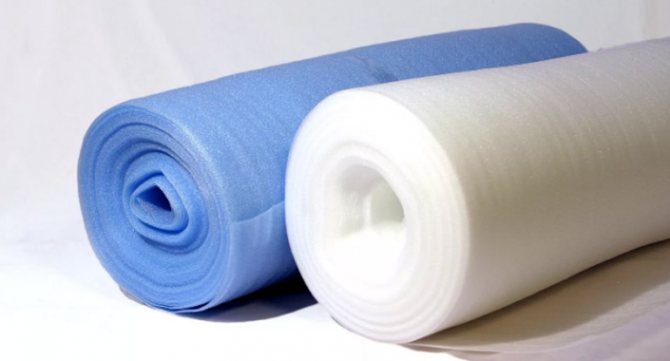

Cut
Foamed polyethylene pipes, which have a technical slot along their entire length, can be easily put on already installed lines. To install them, you do not need to dismantle pipe sections. The edges of the halves are joined end-to-end and glued with metallized tape.
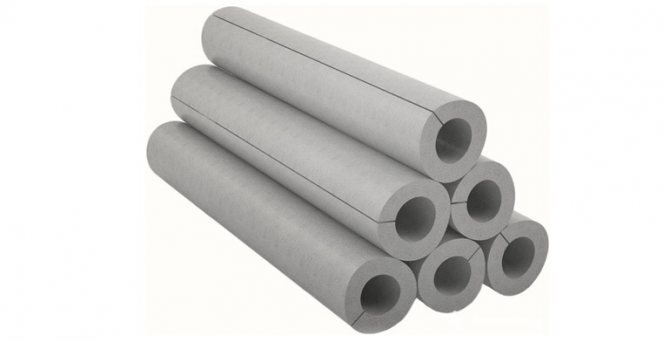

Whole
The thermal insulation material is in the form of hollow cylinders with a solid surface. They are installed on the pipe during the pipeline assembly process.
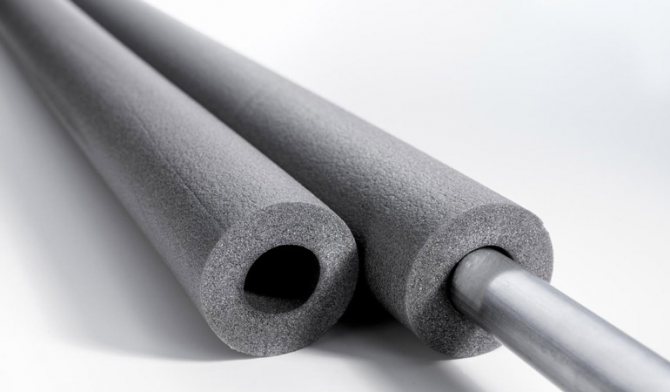

Foil
The material is coated on one or both sides with a thin layer of aluminum foil or metallized film. The maximum adhesion of the layers is achieved by thermal welding. To increase the heat-reflecting effect, the foil is polished. Foil insulation made of foamed polyethylene has:
- Higher coefficient of thermal insulation.
- Shock absorbing qualities.
- Fire resistance.
- UV resistant.
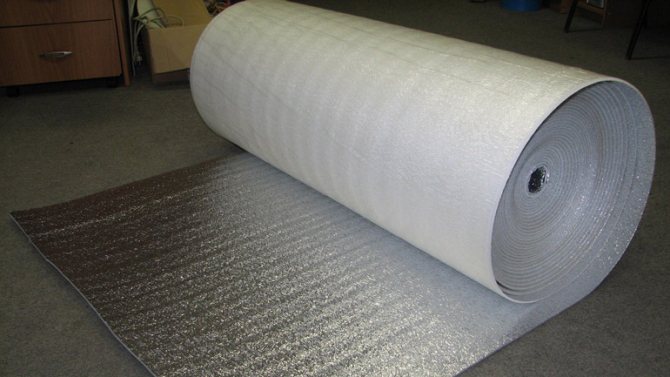

Varieties and their differences
Foam polymers are divided by types of manufacture, on which the quality and price of products depend:
| Uncrosslinked polyethylene foam | It is made of budget material, so its price is lower. It is used for laying insulation layers or packaging electrical equipment. It is rarely used for other purposes. |
| Chemically crosslinked polyethylene foam | To create this type of material, chemicals are used. additives (most often hydrogen peroxide or other catalysts). As a result, polyethylene is obtained several times better and denser than non-crosslinked polyethylene. |
| Physically cross-linked polyethylene foam | For production, solid-state electron emitters are used. Radioactive substances are located around the polymer raw materials and pierce microscopic holes with electrons. The density of the material in this way becomes as high as possible. This type of product is excellent for the production of tubeshell, creating a protective layer around the pipe, but it does not cope well with thermal insulation. This is the most expensive type of polyethylene foam. |
We recommend that you familiarize yourself with: Purpose and application of wafer-type check valves
Overview of manufacturers
I have heard many positive reviews about heaters Vilatherm, Isolon, Penoline, Merilon, EnergoFlex and Thermaflex.
- Vilatherm
Vilatherm is produced by a Moscow company. The material has a fine-mesh structure with closed pores, is hygroscopic, absorbs shock and noise, and is environmentally friendly. Due to the high air content, it has high thermal insulation properties.
The assortment consists of harnesses and cylinders. Insulation in a cylindrical shape is suitable for insulating pipes both in new, installed objects, and for existing, operated pipelines.
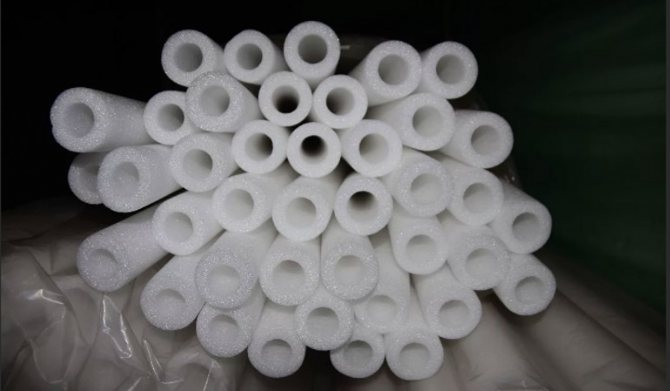

- Izolon, penoline
OJSC Izhevsk Plastics Plant produces two types of sheet insulation with a thickness of 1 to 5 cm under the Izolon trademark:
- NPE - from unstitched.
- PPE, PPE -L, PPE - NR, PPE-NKh - from cross-linked polyethylene foam.
Isolon has a very low heat conductivity coefficient. It reliably protects the room from steam and moisture.


Heat-insulating mats and pipe insulation Penolin are produced by CJSC Information Technologies Plant LIT. It is available in various thicknesses and colors, the width of the blade is 110 and 125mm. It is possible to cover the insulation with aluminum foil, plastic metallized film and other materials.
- Merilon
Insulation pipe MERILON (Czech Republic) is produced with an inner diameter of 15 to 110 mm and a wall thickness of 6 to 18 mm, which causes a different degree of insulation. Foamed polyethylene Merilon has an extremely porous structure.
It is moisture-proof, not subject to decay. The structure with many air cells provides it with good thermal insulation properties.
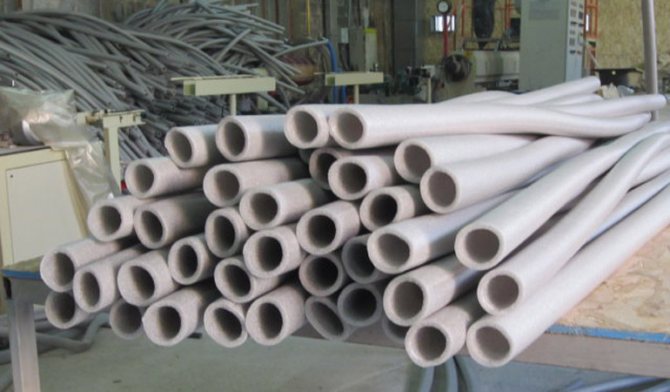

- Energoflex
Energoflex is an environmentally friendly polyethylene foam insulation that meets all European standards in quality. Freon is used for its manufacture, so the material resists the diffusion of water vapor better.
It is used to protect various pipes, containers and fittings from heat loss. Thermal insulation is produced in the form of sheets, rolls and sleeves of various diameters.


- Thermaflex
(Netherlands) produces a wide range of pipe and sheet heaters for engineering systems operating in the temperature range from -80 to +110 ° C. Thermoflex has low thermal conductivity and high resistance to water vapor diffusion, retains good elasticity at subzero temperatures, does not absorb moisture and does not decompose.
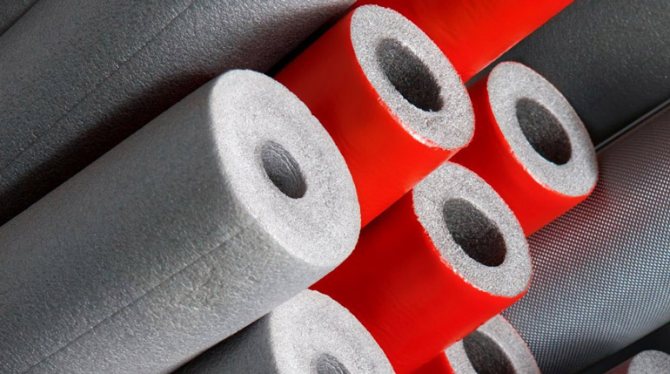

How to choose
When choosing a polyethylene foam insulation, consider the following factors:
- The size and location of the insulated structure. You can insulate the floor using roll materials, heating and sewage pipes - with a shell.Bundles are suitable for sealing gaps in doors and windows.
- The density of the material. The higher the density of the insulation, the greater external loads it can withstand, while maintaining its shape and properties.
- Convenience of installation work.
- The maximum level of heating of the coolant and the lowest temperature in the environment. This criterion influences the choice of the wall thickness of the insulation.
- The reputation of the manufacturer.
approximate price
Average prices from different manufacturers are:
- Vilatherm: a sealing strand with a section of 6 mm - from 3.5 rubles / r.m.
- Merilon: foil-coated (3 mm, length 30 m) - 1450 rubles / roll, 10 mm thick, 15 m long - 2100 rubles / roll.
- Energoflex: pipe insulation: 16 rubles / roll (22 × 9 mm); RUB 150 / roll (110/13 mm).
- Penoline: with a thickness of 2 mm, the cost is 450 rubles; with a thickness of 5 mm - 1030 rubles.
- Thermoflex: 750 rubles / roll (25 m length, 2 mm thickness).
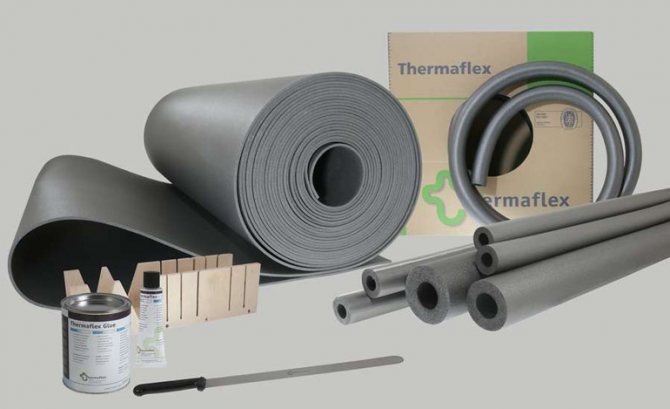

What to look for when choosing
When choosing thermal insulation, the location of the pipes, the density of the material and its size are taken into account:
- To ensure tightness, it is important that the diameter of the insulating tube matches the size of the pipe itself: the material must be in close contact with its surface.
- The thickness of the walls depends on the temperature in the coolant and the lower limit of temperature values in the external environment, as well as on the purpose of thermal insulation: protection against freezing, preventing moisture from appearing on the surface or ensuring the desired temperature on the coating requires the selection of a thermal insulation layer of different thicknesses.
Note! In places where pipes are located on the surface under the rays of the sun, polyethylene foam with a protective polymer layer is used.
One of the important parameters when choosing is the size of the cells of the material. The smaller the size, the greater its ability to retain heat:
We recommend that you familiarize yourself with: Pros and cons of one-pipe and two-pipe heating systems - which is better and more efficient?
| Appointment | The size |
| insulation for cold water pipes | 9 mm |
| insulation for heating and hot water systems | 13-20 mm |
| screed pipes or in walls | 6 mm |
Instructions for use
There are several general rules that must be followed when installing foam insulation:
- The surfaces of the objects to be insulated are prepared in advance. They are cleaned and leveled, cracks and seams are closed.
- All equipment should not work during the thermal insulation work.
- The joints are glued with glue, and the seams are held together with self-adhesive tape.
- There should be a small space between the work surface and the insulation material - an air gap.
- Heat insulators made of polyethylene foam are not recommended to be installed with an overlap, but only end-to-end.
- Foil insulation is mounted with a shiny layer towards the room.
For thermal insulation of the door leaf, it is enough to cut a blank from a sheet of polyethylene foam by measure and fix it on top with a finishing material. On the surface of the enclosing structures from the inside of the house, foamed thermal insulation can be laid under drywall, which will significantly reduce heat loss.
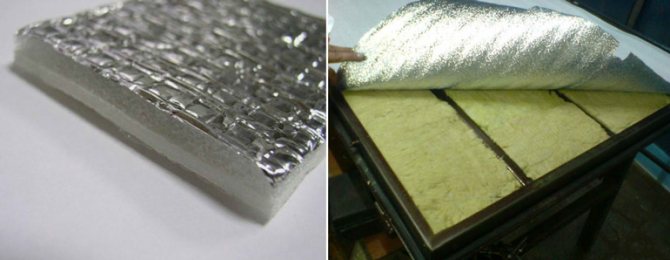

It is better to insulate the balcony or loggia with polyethylene foam with a protective film from ultraviolet radiation or foil material. It will reliably protect these structures from moisture and street noise, while their area will decrease slightly.
Types of products
Polyethylene foam insulation is a huge range of materials that differ in thickness, dimensions and the presence of auxiliary protective coatings. Their scope is not limited only to the insulation of communication wiring:
- Uncoated sheets, films and boards. They are used to protect various equipment (primarily refrigeration).
- Heat insulator coated with a polymer film on both sides. It is used for insulating floors, basements, foundations.
- With one- or two-sided foil.It is in demand in places where additional heat or light reflection and fire resistance are needed (roofs, walls, heaters, radiators, etc.).
- Polyethylene foam tubes. They are thermal insulation for water and heat supply pipes, ventilation and air conditioning systems.
- Harnesses. They are used for laying in seams and gaps of walls, window or door openings.
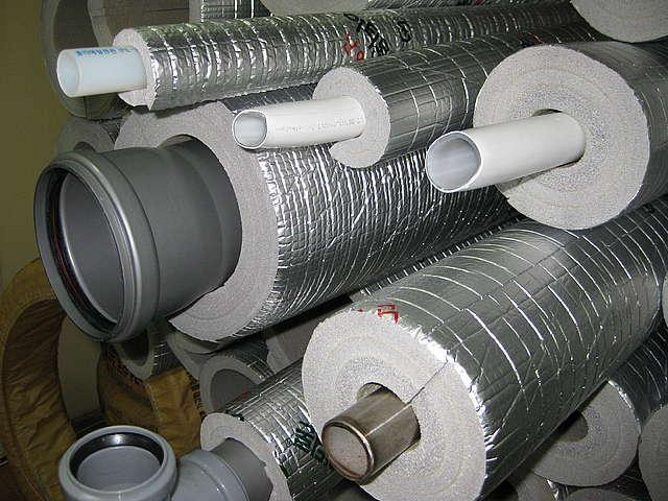

Features of pipe insulation work
The installation of pipe insulation is often performed after the assembly of the pipeline. It is impossible to put on one-piece cylinders on the mounted sections of the pipeline, therefore, products with ready-made cuts are used or cut during installation. The edges of the cut sleeves are fixed with special tape after installation on the pipes.
Installation should begin with surface preparation of the pipes:
- Thorough cleaning of dirt and dust.
- Any abrasive material can be used to remove rust. They need to rub the pipe well, then wash with warm soapy water. The dried pipe can be painted or primed.
I usually glue the outer pipe insulation along the cuts and at the joints. If the pipes are inside the building, then it is not necessary to glue the insulation along the entire length. You can simply fix it with one tape.
Features of installing thermal insulation in places of pipe branching, see the video.
How to calculate insulation for your home
If you need to insulate the walls of the house from the inside, then you need to measure their width and height in all rooms. Then multiply these parameters to calculate the area of each wall separately, and sum the values obtained to determine the total area of insulation. Further, from the amount received, you need to subtract the area of the window and door openings in order to determine the required amount of thermal insulation material.
Pipe insulation is calculated even easier - according to the total length of the pipelines to be insulated.
